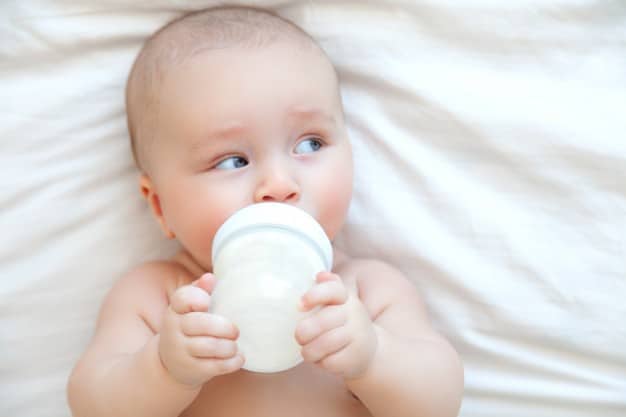Glass baby milk bottles are always my first choice as well as my sister’s first choice when it comes to feeding our babies. We have used glass bottles until our child reaches 18 months of age. Since young, our parents have educated us on how plastic can be harmful and why my mom chose to breastfeed us and used glass bottles on us. Our knowledge about milk bottles increased when I started my baby business.
Even though there is a lot of news and articles on how harmful plastic can be and the importance of BPA Free, unfortunately, I still do see some parents passing down their used milk bottles (I’m talking about those that have been used for few months and some even years) to their family or friends.
Customers came over to ask me to talk to their parents about boiling plastic milk bottles etc..
PLEASE DO NOT BOIL PLASTIC BABY MILK BOTTLES!
Extract from AVA : *Do not put boiling water in baby bottles, as hot water causes bisphenol-A to migrate out of the bottle at a higher rate.*
So I have decided to compile the different type of milk bottles.
NOTE: ALL THIS INFORMATION CAN BE EASILY FOUND ONLINE, I DID NOT MAKE THEM UP MYSELF AND I’M SHARING BASE ON A MOTHER’S POINT OF VIEW!
Baby Milk bottles can be differentiated into PES, PP, PPSU and GLASS

Before I go into details of the baby milk bottles, it’s important to know what exactly is BPA Free.
BPA stands for Bisphenol A. BPA is an industrial chemical that has been used to make certain plastics and resins since the 1960s. Is a chemical that had been used to harden the plastic. Some research showed that BPA can seep into food or beverages from containers that are made with BPA. exposure of BPA is a concern because of possible health effects of BPA on the brain, behaviour and prostate gland of fetuses, infants and children.
Although FDA has said that BPA is safe at the very low levels that occur in some food but they still continue its review and research of BPA.
PP Milk Bottles
PP (Polypropylene), tough and flexible. Can only withstand temperature up to 120°C. A plastic mainly used in household items, reasonably economical. It’s transparent or can be coloured using pigments. PP milk bottles will lose their transparency over time and frequent sterilization or boiling. Limited shelf life. Advised to change every 5-6 months, or where there is a change in texture. Most commonly use milk bottles in the market.
PES Milk Bottles
PES (Polyethersulphone), describes the family of thermoplastic polymers. These polymers are known for their toughness and stability in high temperatures. The size change when exposed to boiling water at 180°C. Is a new plastic to replace BPA. PES bottles have a natural honey-coloured tint. Advised to change every 5-6 months, or where there is a change in texture.
PPSU Milk Bottles
PPSU (Polyphenylsulfone)is high-performance thermoplastic offering better impact resistance and chemical resistance than PP and PES. It can withstand continuous exposure to heat and still absorb tremendous impact without cracking or breaking. Commonly used in aerospace and medical devices which required repeated sterilization. It has a high melting point of 207°C. It does not absorb odour or colour. Naturally BPA Free.
Can change yearly. More costly compare to PES/PP.
Glass bottles
Glass milk bottles have been around for many years and commonly used during our grandparents time. But it’s not widely used during our parents’ era onward because glass is heavier and may cause danger to parents or baby when we drop the glass bottles. But it’s the only milk bottles which don’t leach or released chemicals when exposed to heat. The melting point of 1400°C to 1600°C, depending on the components. No change needed unless you break the glass, or there are cracks.
Best Milk Storage choice
Many have argued that certain storage method is the best, but ultimately is the preference of the individual. Personally I use glass bottles to store my breast milk, and extra supply in breast milk storage bags due to space constraints. Even though till now I have not warmed up any breast milk from my storage bags, but I prefer to pour out rather than warming it directly from the plastic.
Below is the extra from a journal paper regarding the recommended way of storing breast milk, extracted from “The 3 M’s of Breast-feeding the Preterm Infant”
“Several features should be considered when determining the optimal container used for milk storage, including size, need to recycle, ease of cleaning/sterilizing, protection of nutrients, bacteriologic considerations, and ability to connect directly to the pump flange. Studies measuring these factors conclude that glass and hard plastic (polypropylene) are the recommended choices for milk collection/storage.6,10,11 Plastic bags are a poor choice for milk storage for the hospitalized infant owing to their nonsterile condition, greater loss of fat (adherence to sides of the bag), and difficulty in handling.“
I hope this article is useful in helping you to clear your doubts on different types of milk bottles. 🙂







Have A Say